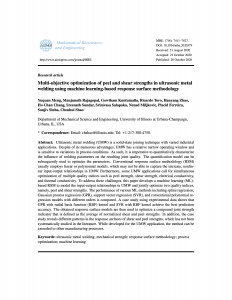Ultrasonic metal welding (UMW) is a solid-state joining method with various industrial applications including battery assembly, automotive body construction, and electronic packaging. Among the advantages of UMW over conventional fusion welding are the ability to join dissimilar metals, reduced energy consumption and short welding time. Despite of its numerous advantages, this technique has a relative narrow operating window and is sensitive to variations in process conditions. Therefore, it is imperative to quantitatively characterize the influence of welding parameters on the resulting joint quality. However, due to the complexity of welding mechanism in UMW, it is difficult to develop an analytic model. This paper employed machine learning based response surface methodology to model the correlation between welding parameters and joint strength. The performance of various ML methods including spline regression, Gaussian process regression (GPR), support vector regression (SVR), and conventional polynomial regression models with different orders is compared. Finally, the parameters for optimal compound joint strength indicator, defined as the average of normalized shear and peel strengths, are attained based on obtained response surface models.
Read the paper here.
